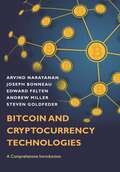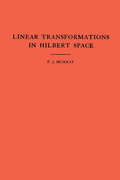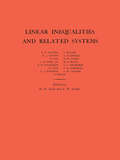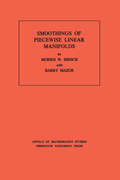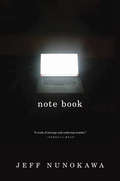- Table View
- List View
Bitcoin and Cryptocurrency Technologies: A Comprehensive Introduction (PDF)
by Arvind Narayanan Joseph Bonneau Edward Felten Andrew Miller Steven GoldfederBitcoin and Cryptocurrency Technologies provides a comprehensive introduction to the revolutionary yet often misunderstood new technologies of digital currency. Whether you are a student, software developer, tech entrepreneur, or researcher in computer science, this authoritative and self-contained book tells you everything you need to know about the new global money for the Internet age.How do Bitcoin and its block chain actually work? How secure are your bitcoins? How anonymous are their users? Can cryptocurrencies be regulated? These are some of the many questions this book answers. It begins by tracing the history and development of Bitcoin and cryptocurrencies, and then gives the conceptual and practical foundations you need to engineer secure software that interacts with the Bitcoin network as well as to integrate ideas from Bitcoin into your own projects. Topics include decentralization, mining, the politics of Bitcoin, altcoins and the cryptocurrency ecosystem, the future of Bitcoin, and more.An essential introduction to the new technologies of digital currencyCovers the history and mechanics of Bitcoin and the block chain, security, decentralization, anonymity, politics and regulation, altcoins, and much moreFeatures an accompanying website that includes instructional videos for each chapter, homework problems, programming assignments, and lecture slidesAlso suitable for use with the authors' Coursera online courseElectronic solutions manual (available only to professors)
Bitcoin and Cryptocurrency Technologies: A Comprehensive Introduction
by Arvind Narayanan Joseph Bonneau Edward Felten Andrew Miller Steven GoldfederBitcoin and Cryptocurrency Technologies provides a comprehensive introduction to the revolutionary yet often misunderstood new technologies of digital currency. Whether you are a student, software developer, tech entrepreneur, or researcher in computer science, this authoritative and self-contained book tells you everything you need to know about the new global money for the Internet age.How do Bitcoin and its block chain actually work? How secure are your bitcoins? How anonymous are their users? Can cryptocurrencies be regulated? These are some of the many questions this book answers. It begins by tracing the history and development of Bitcoin and cryptocurrencies, and then gives the conceptual and practical foundations you need to engineer secure software that interacts with the Bitcoin network as well as to integrate ideas from Bitcoin into your own projects. Topics include decentralization, mining, the politics of Bitcoin, altcoins and the cryptocurrency ecosystem, the future of Bitcoin, and more.An essential introduction to the new technologies of digital currencyCovers the history and mechanics of Bitcoin and the block chain, security, decentralization, anonymity, politics and regulation, altcoins, and much moreFeatures an accompanying website that includes instructional videos for each chapter, homework problems, programming assignments, and lecture slidesAlso suitable for use with the authors' Coursera online courseElectronic solutions manual (available only to professors)
The Power of Networks: Six Principles That Connect Our Lives
by Christopher G. Brinton Mung ChiangWhat makes WiFi faster at home than at a coffee shop? How does Google order search results? Why do Amazon, Netflix, and YouTube use fundamentally different rating and recommendation methods—and why does it matter? Is it really true that everyone on Facebook is connected in six steps or less? And how do cat videos—or anything else—go viral? The Power of Networks answers questions like these for the first time in a way that all of us can understand and use, whether at home, the office, or school. Using simple language, analogies, stories, hundreds of illustrations, and no more math than simple addition and multiplication, Christopher Brinton and Mung Chiang provide a smart but accessible introduction to the handful of big ideas that drive the technical and social networks we use every day—from cellular phone networks and cloud computing to the Internet and social media platforms.The Power of Networks unifies these ideas through six fundamental principles of networking, which explain the difficulties in sharing network resources efficiently, how crowds can be wise or not so wise depending on the nature of their connections, how there are many building-blocks of layers in a network, and more. Understanding these simple ideas unlocks the workings of everything from the connections we make on Facebook to the technology that runs such platforms. Along the way, the authors also talk with and share the special insights of renowned experts such as Google's Eric Schmidt, former Verizon Wireless CEO Dennis Strigl, and "fathers of the Internet" Vint Cerf and Bob Kahn.Networks are everywhere. The Power of Networks shows how they work—and what understanding them can do for you.
Automata Studies. (AM-34), Volume 34 (PDF)
by C. E. Shannon J. MccarthyThe description for this book, Automata Studies. (AM-34), Volume 34, will be forthcoming.
An Introduction to Linear Transformations in Hilbert Space. (AM-4), Volume 4 (PDF)
by Francis Joseph MurrayThe description for this book, An Introduction to Linear Transformations in Hilbert Space. (AM-4), Volume 4, will be forthcoming.
Linear Inequalities and Related Systems. (AM-38), Volume 38
by Harold William Kuhn Albert William TuckerThe description for this book, Linear Inequalities and Related Systems. (AM-38), Volume 38, will be forthcoming.
Smoothings of Piecewise Linear Manifolds. (AM-80), Volume 80
by Morris W. Hirsch Barry MazurThe intention of the authors is to examine the relationship between piecewise linear structure and differential structure: a relationship, they assert, that can be understood as a homotopy obstruction theory, and, hence, can be studied by using the traditional techniques of algebraic topology. Thus the book attacks the problem of existence and classification (up to isotopy) of differential structures compatible with a given combinatorial structure on a manifold. The problem is completely "solved" in the sense that it is reduced to standard problems of algebraic topology. The first part of the book is purely geometrical; it proves that every smoothing of the product of a manifold M and an interval is derived from an essentially unique smoothing of M. In the second part this result is used to translate the classification of smoothings into the problem of putting a linear structure on the tangent microbundle of M. This in turn is converted to the homotopy problem of classifying maps from M into a certain space PL/O. The set of equivalence classes of smoothings on M is given a natural abelian group structure.
Digital Keywords: A Vocabulary of Information Society and Culture (PDF)
by Benjamin PetersIn the age of search, keywords increasingly organize research, teaching, and even thought itself. Inspired by Raymond Williams's 1976 classic Keywords, the timely collection Digital Keywords gathers pointed, provocative short essays on more than two dozen keywords by leading and rising digital media scholars from the areas of anthropology, digital humanities, history, political science, philosophy, religious studies, rhetoric, science and technology studies, and sociology. Digital Keywords examines and critiques the rich lexicon animating the emerging field of digital studies.This collection broadens our understanding of how we talk about the modern world, particularly of the vocabulary at work in information technologies. Contributors scrutinize each keyword independently: for example, the recent pairing of digital and analog is separated, while classic terms such as community, culture, event, memory, and democracy are treated in light of their historical and intellectual importance. Metaphors of the cloud in cloud computing and the mirror in data mirroring combine with recent and radical uses of terms such as information, sharing, gaming, algorithm, and internet to reveal previously hidden insights into contemporary life. Bookended by a critical introduction and a list of over two hundred other digital keywords, these essays provide concise, compelling arguments about our current mediated condition.Digital Keywords delves into what language does in today's information revolution and why it matters.
Digital Keywords: A Vocabulary of Information Society and Culture
by Benjamin PetersIn the age of search, keywords increasingly organize research, teaching, and even thought itself. Inspired by Raymond Williams's 1976 classic Keywords, the timely collection Digital Keywords gathers pointed, provocative short essays on more than two dozen keywords by leading and rising digital media scholars from the areas of anthropology, digital humanities, history, political science, philosophy, religious studies, rhetoric, science and technology studies, and sociology. Digital Keywords examines and critiques the rich lexicon animating the emerging field of digital studies.This collection broadens our understanding of how we talk about the modern world, particularly of the vocabulary at work in information technologies. Contributors scrutinize each keyword independently: for example, the recent pairing of digital and analog is separated, while classic terms such as community, culture, event, memory, and democracy are treated in light of their historical and intellectual importance. Metaphors of the cloud in cloud computing and the mirror in data mirroring combine with recent and radical uses of terms such as information, sharing, gaming, algorithm, and internet to reveal previously hidden insights into contemporary life. Bookended by a critical introduction and a list of over two hundred other digital keywords, these essays provide concise, compelling arguments about our current mediated condition.Digital Keywords delves into what language does in today's information revolution and why it matters.
Modern Database Management, Global Edition (PDF)
by Jeff Hoffer Ramesh Venkataraman Heikki TopiFor introductory courses in Database Management. Provide the latest information in database development Focusing on what leading database practitioners say are the most important aspects to database development, Modern Database Management presents sound pedagogy, and topics that are critical for the practical success of database professionals. The Twelfth Edition further facilitates learning with illustrations that clarify important concepts and new media resources that make some of the more challenging material more engaging. Also included are general updates and expanded material in the areas undergoing rapid change due to improved managerial practices, database design tools and methodologies, and database technology.
Database Systems - A Practical Approach To Design, Implementation, And Management (PDF)
by Thomas Connolly Carolyn BeggThis book is ideal for a one- or two-term course in database management or database design in an undergraduate or graduate level course. With its comprehensive coverage, this book can also be used as a reference for IT professionals. This best-selling text introduces the theory behind databases in a concise yet comprehensive manner, providing database design methodology that can be used by both technical and non-technical readers. The methodology for relational Database Management Systems is presented in simple, step-by-step instructions in conjunction with a realistic worked example using three explicit phases-conceptual, logical, and physical database design. Teaching and Learning Experience This program presents a better teaching and learning experience-for you and your students. It provides: *Database Design Methodology that can be Used by Both Technical and Non-technical Readers *A Comprehensive Introduction to the Theory behind Databases *A Clear Presentation that Supports Learning
Applied Dynamic Programming (PDF)
by Richard E. Bellman Stuart E DreyfusThis comprehensive study of dynamic programming applied to numerical solution of optimization problems. It will interest aerodynamic, control, and industrial engineers, numerical analysts, and computer specialists, applied mathematicians, economists, and operations and systems analysts.Originally published in 1962.The Princeton Legacy Library uses the latest print-on-demand technology to again make available previously out-of-print books from the distinguished backlist of Princeton University Press. These editions preserve the original texts of these important books while presenting them in durable paperback and hardcover editions. The goal of the Princeton Legacy Library is to vastly increase access to the rich scholarly heritage found in the thousands of books published by Princeton University Press since its founding in 1905.
How the Internet Became Commercial: Innovation, Privatization, and the Birth of a New Network
by Shane GreensteinIn less than a decade, the Internet went from being a series of loosely connected networks used by universities and the military to the powerful commercial engine it is today. This book describes how many of the key innovations that made this possible came from entrepreneurs and iconoclasts who were outside the mainstream—and how the commercialization of the Internet was by no means a foregone conclusion at its outset.Shane Greenstein traces the evolution of the Internet from government ownership to privatization to the commercial Internet we know today. This is a story of innovation from the edges. Greenstein shows how mainstream service providers that had traditionally been leaders in the old-market economy became threatened by innovations from industry outsiders who saw economic opportunities where others didn't—and how these mainstream firms had no choice but to innovate themselves. New models were tried: some succeeded, some failed. Commercial markets turned innovations into valuable products and services as the Internet evolved in those markets. New business processes had to be created from scratch as a network originally intended for research and military defense had to deal with network interconnectivity, the needs of commercial users, and a host of challenges with implementing innovative new services.How the Internet Became Commercial demonstrates how, without any central authority, a unique and vibrant interplay between government and private industry transformed the Internet.
How the Internet Became Commercial: Innovation, Privatization, and the Birth of a New Network
by Shane GreensteinIn less than a decade, the Internet went from being a series of loosely connected networks used by universities and the military to the powerful commercial engine it is today. This book describes how many of the key innovations that made this possible came from entrepreneurs and iconoclasts who were outside the mainstream—and how the commercialization of the Internet was by no means a foregone conclusion at its outset.Shane Greenstein traces the evolution of the Internet from government ownership to privatization to the commercial Internet we know today. This is a story of innovation from the edges. Greenstein shows how mainstream service providers that had traditionally been leaders in the old-market economy became threatened by innovations from industry outsiders who saw economic opportunities where others didn't—and how these mainstream firms had no choice but to innovate themselves. New models were tried: some succeeded, some failed. Commercial markets turned innovations into valuable products and services as the Internet evolved in those markets. New business processes had to be created from scratch as a network originally intended for research and military defense had to deal with network interconnectivity, the needs of commercial users, and a host of challenges with implementing innovative new services.How the Internet Became Commercial demonstrates how, without any central authority, a unique and vibrant interplay between government and private industry transformed the Internet.
A Student’s Guide to Python for Physical Modeling (PDF)
by Jesse M. Kinder Philip NelsonPython is a computer programming language that is rapidly gaining popularity throughout the sciences. A Student's Guide to Python for Physical Modeling aims to help you, the student, teach yourself enough of the Python programming language to get started with physical modeling. You will learn how to install an open-source Python programming environment and use it to accomplish many common scientific computing tasks: importing, exporting, and visualizing data; numerical analysis; and simulation. No prior programming experience is assumed.This tutorial focuses on fundamentals and introduces a wide range of useful techniques, including:Basic Python programming and scriptingNumerical arraysTwo- and three-dimensional graphicsMonte Carlo simulationsNumerical methods, including solving ordinary differential equationsImage processingAnimationNumerous code samples and exercises—with solutions—illustrate new ideas as they are introduced. Web-based resources also accompany this guide and include code samples, data sets, and more.
Proceedings of the Princeton Symposium on Mathematical Programming
by Harold William KuhnThis volume contains thirty-three selected general research papers devoted to the theory and application of the mathematics of constrained optimization, including linear programming and its extensions to convex programming, general nonlinear programming, integer programming, and programming under uncertainty.Originally published in 1971.The Princeton Legacy Library uses the latest print-on-demand technology to again make available previously out-of-print books from the distinguished backlist of Princeton University Press. These editions preserve the original texts of these important books while presenting them in durable paperback and hardcover editions. The goal of the Princeton Legacy Library is to vastly increase access to the rich scholarly heritage found in the thousands of books published by Princeton University Press since its founding in 1905.
Partial Differential Equations: An Introduction to Theory and Applications
by Michael Shearer Rachel LevyThis textbook provides beginning graduate students and advanced undergraduates with an accessible introduction to the rich subject of partial differential equations (PDEs). It presents a rigorous and clear explanation of the more elementary theoretical aspects of PDEs, while also drawing connections to deeper analysis and applications. The book serves as a needed bridge between basic undergraduate texts and more advanced books that require a significant background in functional analysis.Topics include first order equations and the method of characteristics, second order linear equations, wave and heat equations, Laplace and Poisson equations, and separation of variables. The book also covers fundamental solutions, Green's functions and distributions, beginning functional analysis applied to elliptic PDEs, traveling wave solutions of selected parabolic PDEs, and scalar conservation laws and systems of hyperbolic PDEs.Provides an accessible yet rigorous introduction to partial differential equationsDraws connections to advanced topics in analysisCovers applications to continuum mechanicsAn electronic solutions manual is available only to professorsAn online illustration package is available to professors
Partial Differential Equations: An Introduction to Theory and Applications
by Michael Shearer Rachel LevyThis textbook provides beginning graduate students and advanced undergraduates with an accessible introduction to the rich subject of partial differential equations (PDEs). It presents a rigorous and clear explanation of the more elementary theoretical aspects of PDEs, while also drawing connections to deeper analysis and applications. The book serves as a needed bridge between basic undergraduate texts and more advanced books that require a significant background in functional analysis.Topics include first order equations and the method of characteristics, second order linear equations, wave and heat equations, Laplace and Poisson equations, and separation of variables. The book also covers fundamental solutions, Green's functions and distributions, beginning functional analysis applied to elliptic PDEs, traveling wave solutions of selected parabolic PDEs, and scalar conservation laws and systems of hyperbolic PDEs.Provides an accessible yet rigorous introduction to partial differential equationsDraws connections to advanced topics in analysisCovers applications to continuum mechanicsAn electronic solutions manual is available only to professorsAn online illustration package is available to professors
Higher Education in the Digital Age
by William G. Bowen Kevin M. GuthrieTwo of the most visible and important trends in higher education today are its exploding costs and the rapid expansion of online learning. Could the growth in online courses slow the rising cost of college and help solve the crisis of affordability? In this short and incisive book, William G. Bowen, one of the foremost experts on the intersection of education and economics, explains why, despite his earlier skepticism, he now believes technology has the potential to help rein in costs without negatively affecting student learning. As a former president of Princeton University, an economist, and author of many books on education, including the acclaimed bestseller The Shape of the River, Bowen speaks with unique expertise on the subject. Surveying the dizzying array of new technology-based teaching and learning initiatives, including the highly publicized emergence of "massive open online courses" (MOOCs), Bowen argues that such technologies could transform traditional higher education--allowing it at last to curb rising costs by increasing productivity, while preserving quality and protecting core values. But the challenges, which are organizational and philosophical as much as technological, are daunting. They include providing hard evidence of whether online education is cost-effective in various settings, rethinking the governance and decision-making structures of higher education, and developing customizable technological platforms. Yet, Bowen remains optimistic that the potential payoff is great. Based on the 2012 Tanner Lectures on Human Values, delivered at Stanford University, the book includes responses from Stanford president John Hennessy, Harvard University psychologist Howard Gardner, Columbia University literature professor Andrew Delbanco, and Coursera cofounder Daphne Koller.
Higher Education in the Digital Age
by William G. Bowen Kevin M. GuthrieTwo of the most visible and important trends in higher education today are its exploding costs and the rapid expansion of online learning. Could the growth in online courses slow the rising cost of college and help solve the crisis of affordability? In this short and incisive book, William G. Bowen, one of the foremost experts on the intersection of education and economics, explains why, despite his earlier skepticism, he now believes technology has the potential to help rein in costs without negatively affecting student learning. As a former president of Princeton University, an economist, and author of many books on education, including the acclaimed bestseller The Shape of the River, Bowen speaks with unique expertise on the subject. Surveying the dizzying array of new technology-based teaching and learning initiatives, including the highly publicized emergence of "massive open online courses" (MOOCs), Bowen argues that such technologies could transform traditional higher education--allowing it at last to curb rising costs by increasing productivity, while preserving quality and protecting core values. But the challenges, which are organizational and philosophical as much as technological, are daunting. They include providing hard evidence of whether online education is cost-effective in various settings, rethinking the governance and decision-making structures of higher education, and developing customizable technological platforms. Yet, Bowen remains optimistic that the potential payoff is great. Based on the 2012 Tanner Lectures on Human Values, delivered at Stanford University, the book includes responses from Stanford president John Hennessy, Harvard University psychologist Howard Gardner, Columbia University literature professor Andrew Delbanco, and Coursera cofounder Daphne Koller.
Creating Symmetry: The Artful Mathematics of Wallpaper Patterns (PDF)
by Frank A. FarrisThis lavishly illustrated book provides a hands-on, step-by-step introduction to the intriguing mathematics of symmetry. Instead of breaking up patterns into blocks—a sort of potato-stamp method—Frank Farris offers a completely new waveform approach that enables you to create an endless variety of rosettes, friezes, and wallpaper patterns: dazzling art images where the beauty of nature meets the precision of mathematics.Featuring more than 100 stunning color illustrations and requiring only a modest background in math, Creating Symmetry begins by addressing the enigma of a simple curve, whose curious symmetry seems unexplained by its formula. Farris describes how complex numbers unlock the mystery, and how they lead to the next steps on an engaging path to constructing waveforms. He explains how to devise waveforms for each of the 17 possible wallpaper types, and then guides you through a host of other fascinating topics in symmetry, such as color-reversing patterns, three-color patterns, polyhedral symmetry, and hyperbolic symmetry. Along the way, Farris demonstrates how to marry waveforms with photographic images to construct beautiful symmetry patterns as he gradually familiarizes you with more advanced mathematics, including group theory, functional analysis, and partial differential equations. As you progress through the book, you'll learn how to create breathtaking art images of your own.Fun, accessible, and challenging, Creating Symmetry features numerous examples and exercises throughout, as well as engaging discussions of the history behind the mathematics presented in the book.
Creating Symmetry: The Artful Mathematics of Wallpaper Patterns
by Frank A. FarrisThis lavishly illustrated book provides a hands-on, step-by-step introduction to the intriguing mathematics of symmetry. Instead of breaking up patterns into blocks—a sort of potato-stamp method—Frank Farris offers a completely new waveform approach that enables you to create an endless variety of rosettes, friezes, and wallpaper patterns: dazzling art images where the beauty of nature meets the precision of mathematics.Featuring more than 100 stunning color illustrations and requiring only a modest background in math, Creating Symmetry begins by addressing the enigma of a simple curve, whose curious symmetry seems unexplained by its formula. Farris describes how complex numbers unlock the mystery, and how they lead to the next steps on an engaging path to constructing waveforms. He explains how to devise waveforms for each of the 17 possible wallpaper types, and then guides you through a host of other fascinating topics in symmetry, such as color-reversing patterns, three-color patterns, polyhedral symmetry, and hyperbolic symmetry. Along the way, Farris demonstrates how to marry waveforms with photographic images to construct beautiful symmetry patterns as he gradually familiarizes you with more advanced mathematics, including group theory, functional analysis, and partial differential equations. As you progress through the book, you'll learn how to create breathtaking art images of your own.Fun, accessible, and challenging, Creating Symmetry features numerous examples and exercises throughout, as well as engaging discussions of the history behind the mathematics presented in the book.
Note Book
by Jeff Nunokawa"The hunger for a feeling of connection that informs most everything I've written flows from a common break in a common heart, one I share with everyone I’ve ever really known."—Note BookEvery single morning since early 2007, Princeton English professor Jeff Nunokawa has posted a brief essay in the Notes section of his Facebook page. Often just a few sentences but never more than a few paragraphs, these compelling literary and personal meditations have raised the Facebook post to an art form, gained thousands of loyal readers, and been featured in the New Yorker. In Note Book, Nunokawa has selected some 250 of the most powerful and memorable of these essays, many accompanied by the snapshots originally posted alongside them. The result is a new kind of literary work for the age of digital and social media, one that reimagines the essay’s efforts, at least since Montaigne, to understand our common condition by trying to understand ourselves.Ranging widely, the essays often begin with a quotation from one of Nunokawa’s favorite writers—George Eliot, Henry James, Gerard Manley Hopkins, W. H. Auden, Robert Frost, or James Merrill, to name a few. At other times, Nunokawa is just as likely to be discussing Joni Mitchell or Spanish soccer striker Fernando Torres.Confessional and moving, enlightening and entertaining, Note Book is ultimately a profound reflection on loss and loneliness—and on the compensations that might be found through writing, literature, and connecting to others through social media.
Note Book
by Jeff Nunokawa"The hunger for a feeling of connection that informs most everything I've written flows from a common break in a common heart, one I share with everyone I’ve ever really known."—Note BookEvery single morning since early 2007, Princeton English professor Jeff Nunokawa has posted a brief essay in the Notes section of his Facebook page. Often just a few sentences but never more than a few paragraphs, these compelling literary and personal meditations have raised the Facebook post to an art form, gained thousands of loyal readers, and been featured in the New Yorker. In Note Book, Nunokawa has selected some 250 of the most powerful and memorable of these essays, many accompanied by the snapshots originally posted alongside them. The result is a new kind of literary work for the age of digital and social media, one that reimagines the essay’s efforts, at least since Montaigne, to understand our common condition by trying to understand ourselves.Ranging widely, the essays often begin with a quotation from one of Nunokawa’s favorite writers—George Eliot, Henry James, Gerard Manley Hopkins, W. H. Auden, Robert Frost, or James Merrill, to name a few. At other times, Nunokawa is just as likely to be discussing Joni Mitchell or Spanish soccer striker Fernando Torres.Confessional and moving, enlightening and entertaining, Note Book is ultimately a profound reflection on loss and loneliness—and on the compensations that might be found through writing, literature, and connecting to others through social media.
Alan Turing: The Book That Inspired the Film "The Imitation Game"
by Andrew Hodges Douglas HofstadterA NEW YORK TIMES BESTSELLERThe official book behind the Academy Award-winning film The Imitation Game, starring Benedict Cumberbatch and Keira KnightleyIt is only a slight exaggeration to say that the British mathematician Alan Turing (1912-1954) saved the Allies from the Nazis, invented the computer and artificial intelligence, and anticipated gay liberation by decades--all before his suicide at age forty-one. This New York Times–bestselling biography of the founder of computer science, with a new preface by the author that addresses Turing's royal pardon in 2013, is the definitive account of an extraordinary mind and life. Capturing both the inner and outer drama of Turing’s life, Andrew Hodges tells how Turing’s revolutionary idea of 1936--the concept of a universal machine--laid the foundation for the modern computer and how Turing brought the idea to practical realization in 1945 with his electronic design. The book also tells how this work was directly related to Turing’s leading role in breaking the German Enigma ciphers during World War II, a scientific triumph that was critical to Allied victory in the Atlantic. At the same time, this is the tragic account of a man who, despite his wartime service, was eventually arrested, stripped of his security clearance, and forced to undergo a humiliating treatment program--all for trying to live honestly in a society that defined homosexuality as a crime. The inspiration for a major motion picture starring Benedict Cumberbatch and Keira Knightley, Alan Turing: The Enigma is a gripping story of mathematics, computers, cryptography, and homosexual persecution.
